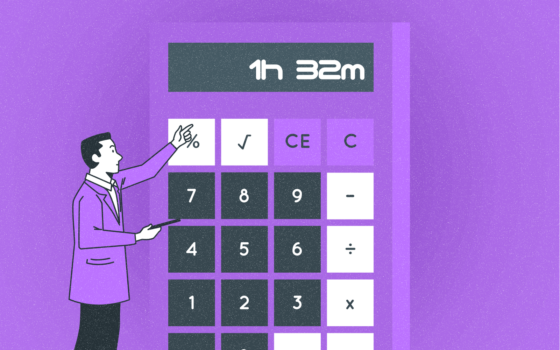Erlang C Calculator for Call Center

The Erlang calculator is an essential tool for call center managers to accurately forecast staffing needs based on call volume. With this calculator, you can determine the optimal number of agents needed to provide efficient service to your customers. Try the call center Erlang calculator and streamline your call center operations!
What is an Erlang Calculator?
An Erlang Calculator is a forecasting tool used to help businesses to calculate the number of staff required to handle a certain volume of calls in their call center. A calculator Erlang call center is particularly useful for call centers that handle inbound and outbound calls. The Erlang staffing calculator works by taking into account the number of calls received, the average handling time for each call, and the number of staff available to handle these calls.
The most commonly used Erlang calculator call center is the Erlang C staffing calculator. This tool is widely used in the call center industry and is known for its accuracy and reliability. Using an outbound call center staffing calculator can help call centers improve their customer service by ensuring that they have enough agents to handle incoming calls, reducing wait times, and increasing customer satisfaction. Additionally, call center managers can save money by ensuring that they are not overstaffed.
Erlang C Calculator
Get more out of your business
Get the best employee engagement content every week via mailing list

How to Use This Erlang Calculator?
A free Erlang calculator is a powerful tool allows you to calculate the number of agents required to handle a given traffic load in a call center environment. You’ll need to enter the following information:
- Call duration: This is the average length of a call in minutes.
- Calls per hour: This is the number of calls you expect to receive in an hour.
- Service level: This is the percentage of calls that you want to be answered within a certain time frame. For example, if you set the service level to 80% within 20 seconds, this means that you want 80% of calls to be answered within 20 seconds.
- Average speed of answer: This is the average amount of time it takes for a call to be answered by an agent in seconds.
- Number of channels: This is the number of phone lines you have available for incoming calls.
In addition to the number of agents, the calculator will also give you other important metrics, such as the average waiting time for callers, the longest expected waiting time, and the percentage of calls that will be blocked (i.e. not able to get through due to lack of available channels).
You can find a variety of free Erlang calculator online according to your needs – from basic calculators to advanced versions with detailed statistical information. You can even find a call centre Erlang calculator as part of a call center management software solution, making it easy to monitor and adjust staffing levels in real time.

Glossary
After Call Work (ACW):
The time an agent spends after a call to complete any necessary administrative tasks, such as entering notes or filing paperwork.
Answer Time:
The amount of time it takes for an agent to answer a customer’s call.
Average Handle Time (AHT):
The average time it takes for a call center agent to handle a customer call, including talk time and any after-call work.
Average Speed of Answer (ASA):
The average amount of time a caller waits in the queue before an agent answers the call.
Abandoned Call:
A call that was terminated by the caller before being answered by an agent.
Agent:
A call center employee who handles customer calls and provides support.
Automatic Call Distributor (ACD):
A software system used by call centers to automatically distribute the traffic of incoming calls to available agents based on predefined rules and criteria.
Call Blending:
A process that allows agents to handle both inbound and outbound calls during the same shift.
Callback:
A feature that allows customers to request a call back from an agent instead of waiting on hold.
Call Center:
A centralized facility where agents handle customer calls and provide support.
Call Deflection:
This refers to the practice of diverting incoming calls to self-service channels such as IVR or chatbots to reduce the workload of agents.
Caller ID:
A feature that displays the phone number of the person calling.
Call Monitoring:
The process of listening to and recording customer calls for quality assurance purposes.
Call Recording:
The process of recording customer calls for training, quality assurance, or compliance purposes.
Call Volume:
The number of calls received by a call center over a given period of time.
Customer Relationship Management (CRM):
A software system used by call centers to manage customer interactions, track customer information, and improve customer service.
Dialer:
A system that automatically dials outbound calls for agents.
Escalation:
The process of transferring a call to a higher authority or manager for resolution.
Erlang Calculator:
A tool developed by the Danish mathematician Agner Krarup Erlang which is used to help businesses calculate the number of staff required to handle a certain volume of calls in their call center.
Erlang C:
The most commonly used Erlang Calculator, also known for its accuracy and reliability.
First Call Resolution (FCR):
The percentage of calls that are resolved on the first call without the need for further follow-up.
Forecasting:
The process of predicting future demand for resources, such as staff or phone lines. A call center forecasting calculator is mainly used for this feature.
Headcount:
The total number of employees needed to handle the workload.
Hold Time:
The amount of time a caller waits on hold before being connected to an agent.
Interactive Voice Response (IVR):
A system that interacts with callers through voice prompts and allows them to select options via keypad.
Inbound Call:
A call initiated by a customer.
Key Performance Indicators (KPIs):
These are metrics used to measure the performance of call centers, such as AHT, ASA, FCR, customer satisfaction, and agent productivity.
Lead Generation:
The process of identifying and qualifying potential customers.
Live Chat:
A method of customer service that allows customers to chat with agents in real-time via a website or mobile app.
Metrics:
Data used to measure call center performance, such as AHT, FCR, and ASA.
Multichannel Contact Center:
The ability to handle customer inquiries through multiple channels, such as phone, email, and chat.
Net Promoter Score (NPS):
A metric used to measure customer loyalty and satisfaction.
Occupancy Rate:
The percentage of time agents are on calls or completing after-call work.
Offshore Call Center:
A call center located in a different country than the company it serves.
Onshore Call Center:
A call center located in the same country as the company it serves.
Outbound Calling:
A process where agents make calls to customers or prospects for sales, marketing, or support purposes.
Overflow Call:
A call that is routed to another department or outsourced call center when the primary center is at capacity.
Predictive Dialer:
A system that uses algorithms to predict when agents will be available to handle calls and dials accordingly.
Quality Assurance (QA):
The process of monitoring calls and providing feedback to agents to improve performance.
Queue:
The line of calls waiting to be answered by an agent.
Sales Conversion Rate:
The percentage of calls that result in a sale or conversion.
Service Level Agreement (SLA):
An agreement between two parties that outlines the quality and speed of service that is expected from one party (typically a call center). It is usually expressed as a percentage.
Service Level Objective (SLO):
The service level objective (SLO) is usually expressed as a percentage of calls answered within a certain time frame.
Surveys:
Feedback tools used to measure customer satisfaction and improve call center performance.
Scripting:
The practice of providing agents with pre-written scripts to help them handle customer interactions more efficiently and professionally.
Speech Analytics:
The process of analyzing recorded calls for data and insights to improve call center performance.
Silent Monitoring:
The practice of listening to live or recorded calls without the caller or agent’s knowledge.
Skill-Based Routing:
A system that routes calls to agents based on their skills, experience, or other predefined criteria.
Talk Time:
The amount of time that an agent spends actively talking with a customer during a call.
Technical Support:
The process of providing assistance to customers with technical issues or product-related inquiries.
Telemarketing:
The process of selling products or services over the phone.
Training:
The process of providing agents with the necessary skills and knowledge to handle customer inquiries and provide excellent service.
Third-Party Call Center:
A call center that is outsourced to a third-party vendor.
Ticketing System:
A software system that tracks customer inquiries, issues, and resolutions.
Total Working Time:
The total amount of time available to the team for handling calls in a given period of time.
Up-Selling:
The process of offering customers an upgrade or higher-priced product during a call.
Virtual Call Center:
A call center that allows agents to work from remote locations.
Voice of the Customer (VoC):
The process of capturing customer feedback and using it to improve call center performance.
Voicemail:
A system that allows customers to leave a message when an agent is not available.
Workforce Management (WFM):
A software system used by call centers to forecast call volumes, schedule agents, and manage staffing levels more effectively.
Workload:
Generally refers to the amount of work that needs to be done in a given period of time. It includes both tasks and calls.
Wrap-Up Code:
A code used by agents to categorize the reason for a call.
Wrap-Up Time:
The amount of time an agent spends after a call to complete any necessary documentation or follow-up tasks.
Zero Queue:
The process of routing calls to agents immediately, without putting them in a queue.
24/7 Support:
Customer service that is available around the clock.


